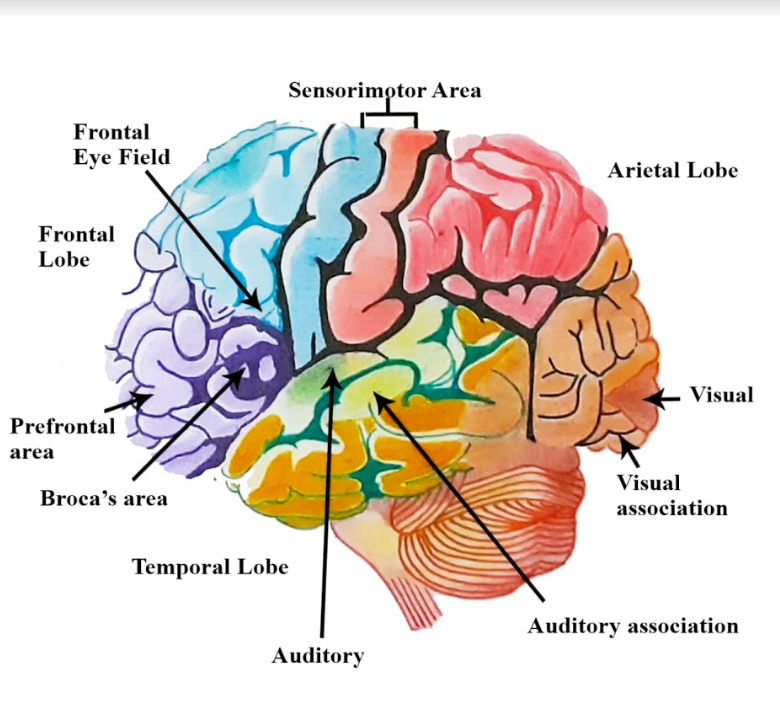
What are the functions of the cerebrum, cerebellum, and medulla oblongata.
Answer
495k+ views
Hint: The brain is divided into the cerebrum, the midbrain, the pons, the medulla, and the cerebellum. The brain stem acts as a relay centre connecting the cerebrum and cerebellum to the spinal cord. It performs many of the body’s automatic functions.
Complete step by step answer:
- The cerebrum serves to control and coordinate movement, temperature, touch, vision, hearing, judgment, reasoning, problem- solving abilities, emotions, and learning.
- The medulla oblongata’s function includes regulating several basic functions of the autonomic nervous system, including respiration, cardiac function, vasodilation, and reflexes like vomiting, coughing, sneezing, and swallowing.

- The function of the cerebellum is to coordinate voluntary muscle movements and also to maintain posture, balance, and equilibrium.
The functions of other parts of the brain are:
- The midbrain serves as the control centre of motor movement, particularly movements of the eye, and in auditory and visual processing.
- The pons functions are to relay signals from the forebrain to the cerebellum, along with dealing with voluntary and involuntary movements such as sleep, respiration, swallowing, bladder control, hearing, equilibrium, taste, eye movement, facial expressions, facial sensation, and posture.
Notes: The nervous system consists of two main parts: The central nervous system is made up of the brain and spinal cord. The peripheral nervous system is made up of nerves that arise from the spinal cord and innervates all parts of the body. Each side of the brain comprises four lobes. The frontal lobe is significant in cognitive functions and control of voluntary movements of the body. The parietal lobe deals with the information about temperature, taste, touch, and movement, and the occipital lobe is principally responsible for the vision. The temporal lobe handles the functions related to memories, combining them with sensations of taste, sound, sight, and touch.
Complete step by step answer:
- The cerebrum serves to control and coordinate movement, temperature, touch, vision, hearing, judgment, reasoning, problem- solving abilities, emotions, and learning.
- The medulla oblongata’s function includes regulating several basic functions of the autonomic nervous system, including respiration, cardiac function, vasodilation, and reflexes like vomiting, coughing, sneezing, and swallowing.

- The function of the cerebellum is to coordinate voluntary muscle movements and also to maintain posture, balance, and equilibrium.
The functions of other parts of the brain are:
- The midbrain serves as the control centre of motor movement, particularly movements of the eye, and in auditory and visual processing.
- The pons functions are to relay signals from the forebrain to the cerebellum, along with dealing with voluntary and involuntary movements such as sleep, respiration, swallowing, bladder control, hearing, equilibrium, taste, eye movement, facial expressions, facial sensation, and posture.
Notes: The nervous system consists of two main parts: The central nervous system is made up of the brain and spinal cord. The peripheral nervous system is made up of nerves that arise from the spinal cord and innervates all parts of the body. Each side of the brain comprises four lobes. The frontal lobe is significant in cognitive functions and control of voluntary movements of the body. The parietal lobe deals with the information about temperature, taste, touch, and movement, and the occipital lobe is principally responsible for the vision. The temporal lobe handles the functions related to memories, combining them with sensations of taste, sound, sight, and touch.
Recently Updated Pages
Master Class 9 General Knowledge: Engaging Questions & Answers for Success

Master Class 9 English: Engaging Questions & Answers for Success

Master Class 9 Science: Engaging Questions & Answers for Success

Master Class 9 Social Science: Engaging Questions & Answers for Success

Master Class 9 Maths: Engaging Questions & Answers for Success

Class 9 Question and Answer - Your Ultimate Solutions Guide

Trending doubts
State and prove Bernoullis theorem class 11 physics CBSE

What are Quantum numbers Explain the quantum number class 11 chemistry CBSE

Who built the Grand Trunk Road AChandragupta Maurya class 11 social science CBSE

1 ton equals to A 100 kg B 1000 kg C 10 kg D 10000 class 11 physics CBSE

State the laws of reflection of light

One Metric ton is equal to kg A 10000 B 1000 C 100 class 11 physics CBSE




